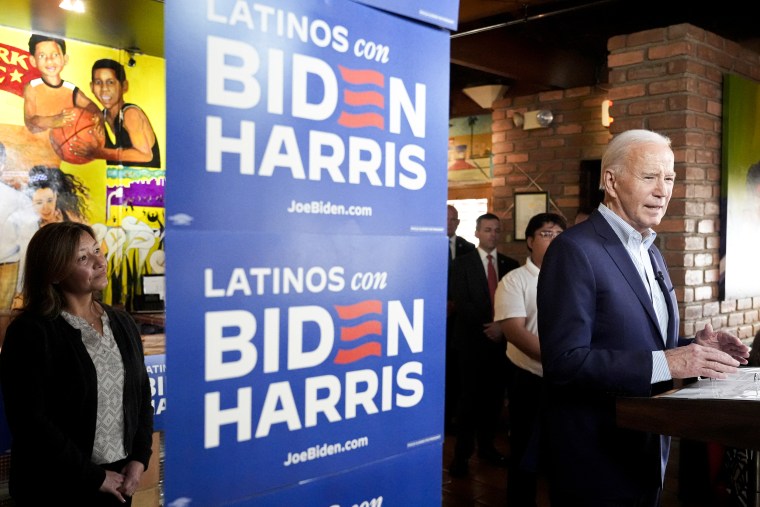President Joe Biden’s re-election campaign has been criticized for not being responsive to the country’s estimated 36.2 million eligible Latino voters. But the campaign can take some comfort in a new Pew Research poll released last week, which showed the incumbent creeping back to the 2020 levels of Latino support that helped put him in the White House.
Pew’s poll showed Biden winning 52% of Latinos to Donald Trump’s 44%, an increase from other national polls that had him with some of the lowest Latino support of any Democratic presidential candidate since Jimmy Carter’s defeat in 1980. In the 2020 election, as Pew noted with a validated voter analysis, 59% of Latino voters chose Biden, with Trump earning 38%.
Pew estimates there will be roughly 36.2 million eligible Latino voters by November 2024, which is 4 million more than in 2020.
Democratic dreams of Biden matching the 70% share of Latinos that Barack Obama and Bill Clinton achieved are unrealistic in 2024. He would be hard-pressed even to attain the 66%-28% advantage Hillary Clinton had over Trump in 2016. Still, closing a 7 percentage-point gap from one cycle to another this early in the campaign is quite achievable. And while Democrats have had recent challenges with outreach to Latinos, it’s clear that Latinos will be central to a Biden victory, especially in six key toss-up states: Pennsylvania, Michigan, Wisconsin, Arizona, Nevada and Georgia.
There are several factors to consider as to why such a scenario is plausible.
First, the number of new Latino voters continues to increase. Pew estimates there will be roughly 36.2 million eligible Latino voters by November 2024, which is 4 million more than in 2020. The expected 2024 Latino voter turnout is currently at around 17.5 million, which means that more than half of eligible Latino voters are persuadable.
As NBC News reported this week, “In the western U.S., which includes the battlegrounds of Arizona and Nevada, Latinos are nearly 4 of every 10 newly eligible voters — defined as those who have reached ages 18 or 19 since the 2022 midterms. In the South, Latinos are 24% of newly eligible voters, and in the Northeast they make up 19%.”
With so much in play, local outreach and messaging will be crucial in the fight to win over new voters and possibly bring some Latino voters back into the Democratic fold, especially in states like Pennsylvania, Michigan and Wisconsin. Although these states have Latino voter shares in the single digits (anywhere from 4% to 6%), a consistent campaign presence could make enough of a difference to win a state’s electoral votes.
The Republican National Committee has cut back dramatically on community centers aimed at increasing Latino voter support.
Second, Republicans have had their own troubles with Latino outreach. As first reported by The Messenger before that outlet shut down, the Republican National Committee has cut back dramatically on community centers aimed at increasing Latino voter support. Plans to revive its outreach efforts to Black and Latino voters have shuttered completely, according to The Daily Beast.

Subsequent reporting has Republicans questioning if the Trump campaign’s elusive push to win more Latino and Black support is just hyperbole. A story last Friday from The Keystone, a Pennsylvania-based outlet, said that while the Biden campaign opened up 10 offices across the state, “Republicans have been non-existent.” With the RNC’s closure of community centers, one former Allentown location is now a cash-checking store and another in Philadelphia is a child care center, the outlet reported.
In a statement to The Keystone, José Muñoz, a spokesperson for the Democratic Congressional Campaign Committee, said, “While Democrats are trying to meaningfully and thoughtfully engage with these voters, Republicans are only interested in a publicity stunt.”
There are other indications that Democrats and Biden can still do well with Latino voters. The campaign has reportedly made peace with Spanish-language network Univision, after last year’s interview with Trump caused friction. The president’s interview with the network in April didn’t lead to any political disaster or fallout. In addition, while the April Axios/Ipsos poll conducted in partnership with Noticias Telemundo noted that Biden’s approval ratings with Latinos were at just 41%, Trump’s rating came in at a dismal 32%. The same poll acknowledged that 36% of Latinos believed Democrats better represent them, compared to just 16% who felt the same way about Republicans.
The Biden camp also continues to tout its Latino outreach efforts as coming earlier than in previous cycles. It knows it needs young Latino voters too, so reports that this segment of voters is disillusioned should be taken seriously.
“I think that Latino voters know how much is at stake, but there is an information gap. Our job on this campaign is to reach folks and connect the dots,” said Michelle Villegas, the Biden campaign Latino engagement director, to Politico in April.
It’s premature to conclude that Democrats have lost the party’s edge with Latinos forever.
As a result, it does appear that the strategy of approaching Latino voters with swing-state resources could finally be hitting home with Democrats. As I said in a post-2020 election appearance on NPR about Latino support and political parties, “[Latinos] represent different ideologies. We come from different backgrounds, different demographics, economic status — working class, you know, middle class, upper class. It’s changing. We’re white. We’re Black. We’re Indigenous. We’re mixed. Figure it out. It’s like — there’s no longer Hispanic media. It’s what it is. It’s like we’re swing states. That’s who we are.”
It’s premature to conclude that Democrats have lost the party’s edge with Latinos forever. Democratic-leaning Latino voters remain a key reason why states like California, New York and Illinois are consistently blue. But real work will need to happen in swing states, engaging Latinos there to provide just enough support to win.
Fortunately for Democrats, it looks like the Biden campaign finally got the message.
